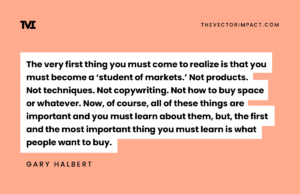Table of Contents
Copywriting is one of the most valuable skills in the world.
If you learn how to write words that sell, you’ll never go broke.
Use the wisdom from these seven copywriting quotes and start printing massive amounts of cash as soon as possible.
This may seem obvious, but most copywriters and business owners miss this

You can write the most stylish copy ever invented, but if you’re selling something nobody wants to buy, it won’t work. A ton of the work should be done not only before you write the copy but before you decide whether or not the thing you want to sell is worth selling at all.
You shouldn’t be afraid of established markets. You can sell in established markets because there’s proof that people want to buy products in those markets.
If you’re launching something so original that there’s nothing like it at all, chances are your product is a dud. You can determine what to sell by studying what already sells well in your niche.
Then, you can figure out how to differentiate yourself. You can simply create something similar with some sort of unique advantage, like achieving the same result faster.
If you want to pick a winning market, follow these four indicators I learned from Alex Hormozi:
- A growing market: Marketing to SaaS companies will be easier than newspapers.
- People with a clear pain point: The deeper the pain, the more you can charge.
- The money to pay you (often overlooked): As Hormozi likes to say, “Solve rich people’s problems. They pay more.”
- A market you can target: Find customers you know how to find (e.g., finding people who have demographics you can find on Facebook Ads).
To write copy that sells, your words must drive action

At the end of the day, the only job your copy has is to get people to take the next step, whether it’s to:
- Click a link
- Sign up for your email list
- Buy your product
That last one is the most important.
The writing itself is a tiny part of the equation when it comes to copywriting.
The bulk of the work is figured out beforehand by first doing enough market research to determine whether the product you want to sell is something other people want to buy.
Your copy should focus on the main reasons people want to buy products:
- Make money
- Save money
- Save time
- Avoid effort
- Escape mental or physical pain
- Get more comfort
- Achieve greater health
- Gain praise
- Feel more loved
- Increase their popularity or social status
This copywriting quote offers an exercise you can try (from the book “Copywriting Secrets”):
For each of those main categories for why people buy, come up with multiple answers for each reason. If you took the time to list out all those answers, you’d either have a ton of material to use in your sales copy or come to the realization your product might not serve as many needs as you think it does. Either way, you’ve just gained important insights.
—Jim Edwards
The most important part of every single piece of copy you write

If you whiff on the headline, you could potentially lose out on mountains of cash.
Whether you’re writing…
- A sales page
- Copy for a website homepage
- A blog post
- An opening tweet for a thread
- Or an ad on Facebook
…your headline matters above all else.
A good headline speaks to the reasons people want to buy.
Another useful copywriting quote on writing stellar headlines:
John Caples is often cited as the greatest copywriter of all time. He says ‘first and foremost, try to get self-interest into every headline you write. Make your headline suggest to readers that here is something they want. This rule is so fundamental that it would seem obvious. Yet the rule is violated every day by scores of writers.’
—Chip and Dan Heath, “Made to Stick”
Business owners who don’t know how to write copy will whiff on this often when they have headlines for their homepage that read, “Our Family Company Was Started in 1972,” which nobody cares about.
In general, realize that your potential customers don’t care about you or your business at all.
They care about what your business can do for them.
If you create content, they care about what that content can do for them.
And your headline helps most of them decide whether or not you’re going to be able to help them at all.
Headline formats that work well:
- Discover the Secret to [Desirable Outcome] with [Your Product or Service]!
- Get [Desirable Outcome] in [Short Timeframe] with [Your Product or Service]!
- Transform Your [Problem or Pain Point] into [Desirable Outcome] with [Your Product or Service]!
- Unlock the Power of [Your Product or Service] and Achieve [Desirable Outcome]!
- Say Goodbye to [Problem or Pain Point] and Hello to [Desirable Outcome] with [Your Product or Service]!
They might seem a bit gimmicky, but if you look at a lot of successful sales pages, they have these over-the-top headlines that seem a bit goofy but work nonetheless.
This copywriting quote proves people don’t buy drills, they buy holes

Doing the exercise above will help you avoid the classic mistake most people make when trying to sell something.
They focus on what the product is more than they focus on what it does.
Nobody wants an exercise routine. They want to look good naked.
Nobody wants to buy an online course with 12 videos about how to make more money. They want to make the money itself (and do it as quickly as possible).
You get the point.
When you’re writing the copy, focus on:
- What their lives will be like after they’ve bought the product (paint the picture of success)
- Any sort of transformation the product will cause
- How your product will make their life easier, more convenient, and move them closer to their desired result faster
Don’t make the mistake of thinking that a bunch of bells and whistles will make your product more appealing. Sometimes, the opposite is true. Having too many features, especially features without clearly defined benefits, can just confuse your audience and make it even more difficult for them to buy.
Benefits > features. Every single time.
Try this exercise to get better at writing copy

Copying sales letters by hand is a practice that’s been passed down from copywriter to copywriter over the years.
Some of the reasons why it works are:
- You put yourself in the mind of the person who wrote the page, which gives you insights via this weird osmosis-like process.
- You’ll eventually notice patterns that continue to emerge across different pieces of copy that sell well.
- Reading the copy aloud and writing it down by hand helps you absorb the information more than you would just by reading alone.
- You’ll pick up on the strong sections of the copy that cause an emotional response.
- You’ll learn how to waste fewer words and write copy that flows.
This is one of those techniques that also separates those who are serious about writing words that sell and those who are just pretending. Writing down copy by hand takes a lot of effort, especially if you’re copying a long sales letter (which most successful sales letters are).
Doing it once is hard enough. Doing it over and over again until you have a deep subconscious knowledge of how to write copy that sells? That raises the bar so high that only those who want to win badly will do it.
Do these 5 things to write copy that sells

You want your prospect to feel like you’re on their side, understand their needs, and have what it takes to help them make the transformation they’re looking for.
If you focus on these five areas, you’ll do just that:
- Encourage their dreams: Inspirational content is popular for a reason. People need a pick-me-up in a world that often drags them down.
- Justify their failures: Nobody wants to feel like the problems in their lives are their fault. You can frame your product as a new and unique solution that will help them solve the problem the other solutions failed to do.
- Allay their fears: Usually, the biggest fear is uncertainty. Or that they’ll try to solve the core problem and fail at it once again. Talk about how your product will give them ease, convenience, and peace of mind.
- Confirm their suspicions: This is where you proactively call out some of the things they already believe to be true, like the idea that most make-money online courses are scams (except for yours, of course).
- Throw rocks at their enemies: As you can see in areas like politics, creating an out-group is a strong persuasion tool. Find a way to throw rocks at a philosophy; a way of doing things; or a nebulous group of people you disagree with, like a fitness coach throwing rocks at those who say you have to track calories and eat boring diets to lose weight.
Keep swinging until you hit a home run

In order to improve, this copywriting quote reveals an important truth about failure:
You often figure out what does work by first learning what doesn’t work.
Each time you write a piece of copy, measure it by how well the product sold. If it didn’t sell as well as you hoped, do a post-mortem analysis and see what needs to be improved:
- Was the headline off?
- Did you position the product correctly?
- Were the benefits clear?
- Was the copy easy to read?
- Did you make it clear what you wanted the reader to do next?
The best copywriters are good at course correcting over time. There’s no substitute for doing the work. And if you do it often enough, bouncing from failure to failure without losing any enthusiasm, you’ll eventually strike gold.
You only need one campaign to go well to change the trajectory of your life and the size of your bank account. Keep swinging until you hit a grand slam.


